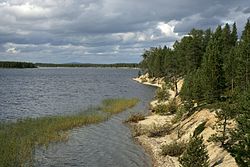Kovdorsky District
| Kovdorsky District Ковдорский район (Russian) |
|
|---|---|
 Location of Kovdorsky District in Murmansk Oblast |
|
| Coordinates: 67°34′N 30°28′E / 67.567°N 30.467°ECoordinates: 67°34′N 30°28′E / 67.567°N 30.467°E | |
 Pirengensky Reserve, Kodvorsky District |
|
|
|
|
| Location | |
| Country | Russia |
| Federal subject | Murmansk Oblast |
| Administrative structure (as of March 2013) | |
| Administrative center | town of Kovdor |
| Administrative divisions: | |
| Towns | 1 |
| Territorial okrugs | 1 |
| Inhabited localities: | |
| Cities/towns | 1 |
| Rural localities | 5 |
| Municipal structure (as of October 2007) | |
| Municipally incorporated as | Kovdorsky Urban Okrug |
| Local government: | |
| Head | Nikolay Karelsky |
| Representative body | Council of Deputies |
| Statistics | |
| Area (urban okrug) (2015) | 4,066 km2 (1,570 sq mi) |
| Population (2010 Census) | 21,297 inhabitants |
| • Urban | 88.4% |
| • Rural | 11.6% |
| Density | 5.24/km2 (13.6/sq mi) |
| Time zone | MSK (UTC+03:00) |
| Established | November 29, 1979 |
| Official website | |
| on | |
Kovdorsky District (Russian: Ковдо́рский райо́н) is an administrative district (raion), one of the six in Murmansk Oblast, Russia. It is located to the west of the Kola Peninsula. The area of the district is 4,066 square kilometers (1,570 sq mi). Its administrative center is the town of Kovdor. Population: 21,297 (2010 Census);24,404 (2002 Census);36,786 (1989 Census). The population of Kovdor accounts for 88.4% of the district's total population.
The district was formed by the November 29, 1979 Decree by the Presidium of the Supreme Soviet of the Russian SFSR from parts of the territory subordinated to the town of Apatity.
As a municipal division, the territory of the district is incorporated as Kovdorsky Urban Okrug (Ковдо́рский городско́й о́круг).
The majority industries in the area are metallurgy and building materials. Mining is also a very important industry, and it was one of the earliest industries in the region. Minerals mined in the district include mica, iron, and vermiculite. Commercial production of mica in the district began in 1934.
As of 2010, the district's population is 21,297. The population is declining due to emigration and natural decrease.
...
Wikipedia


